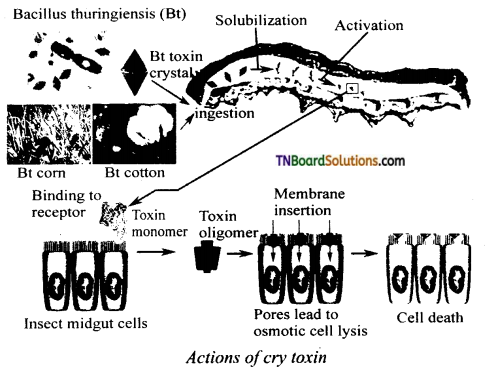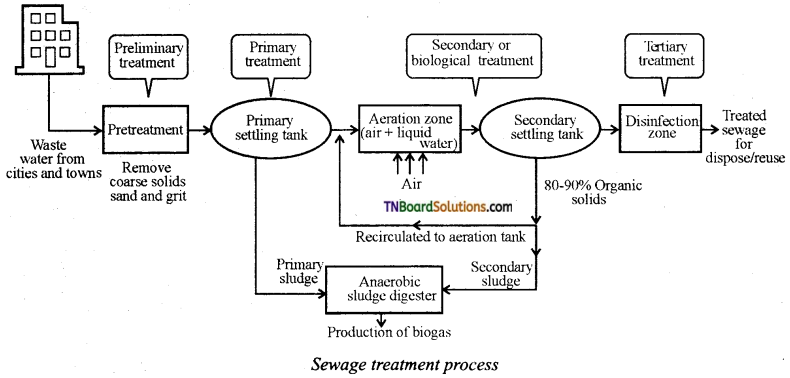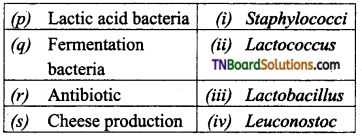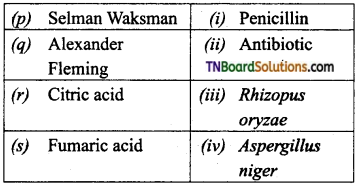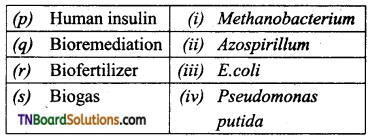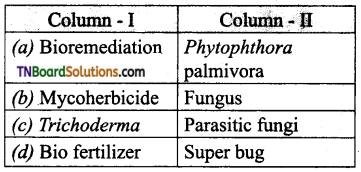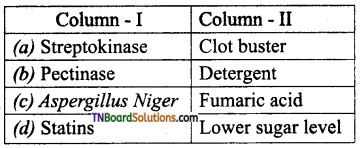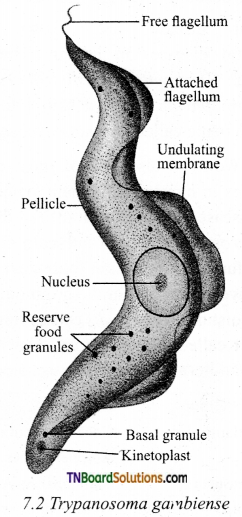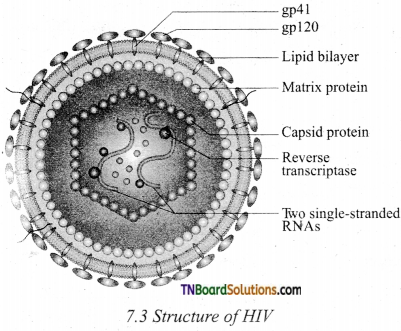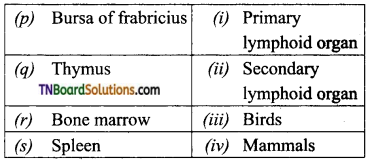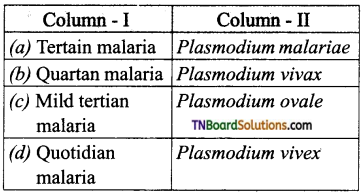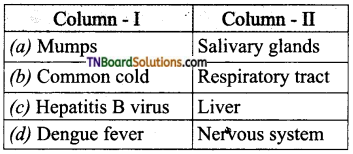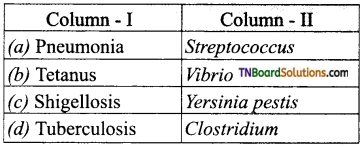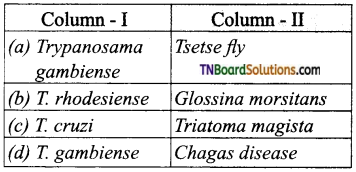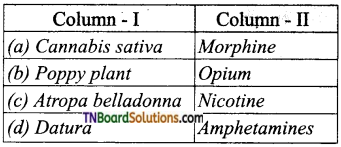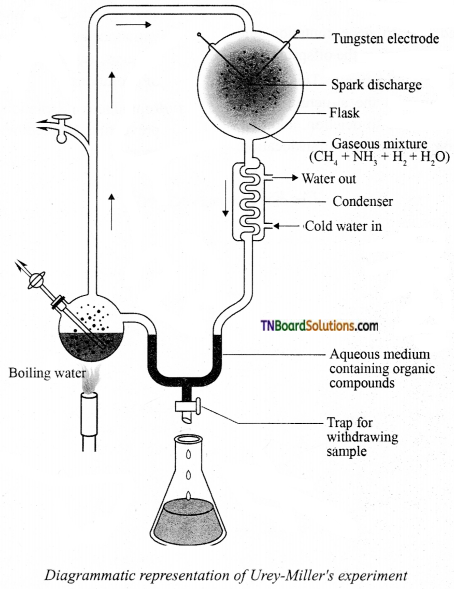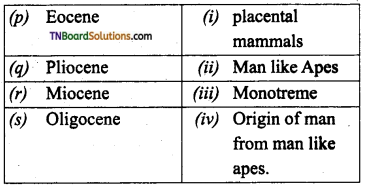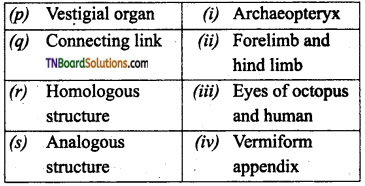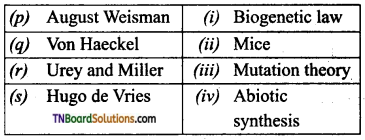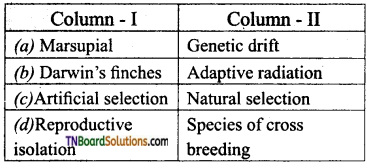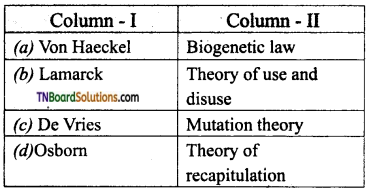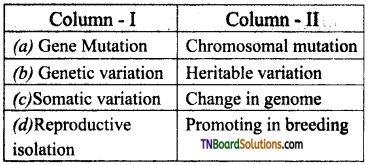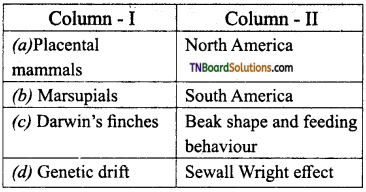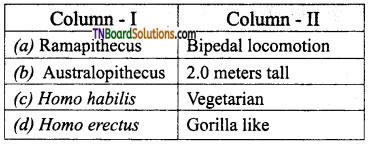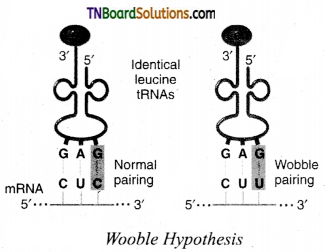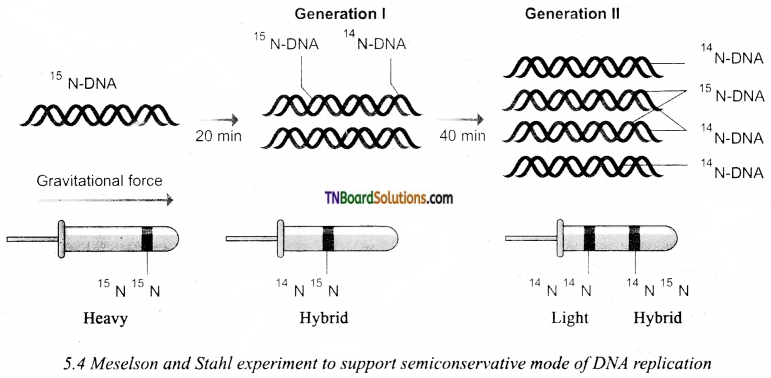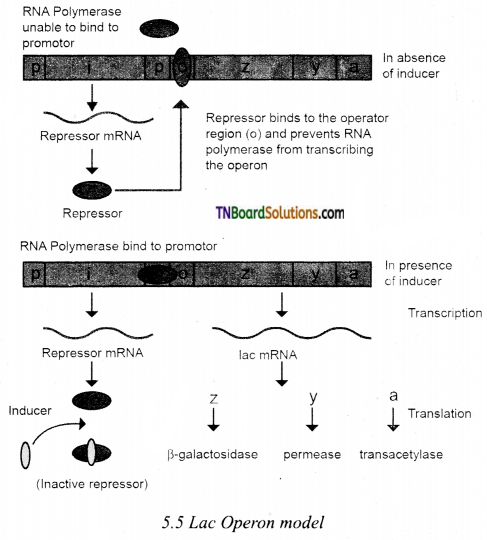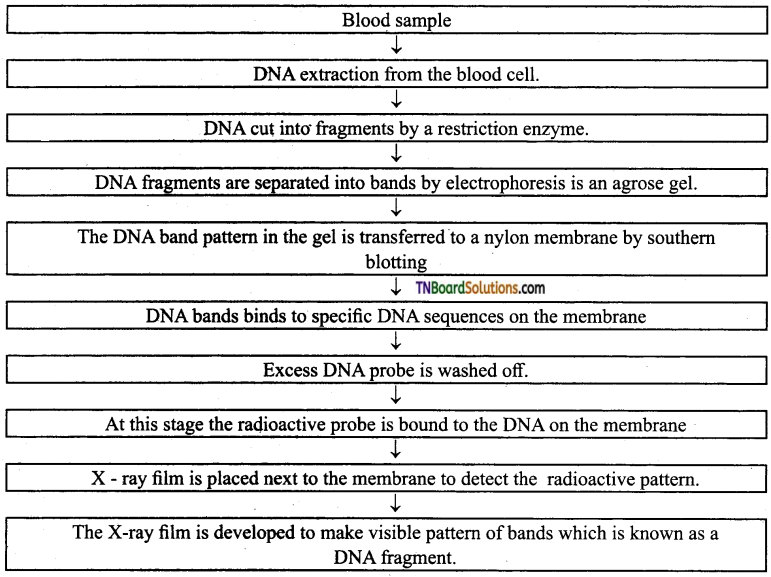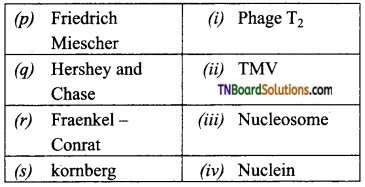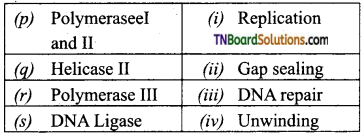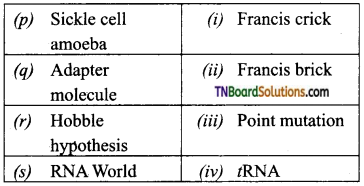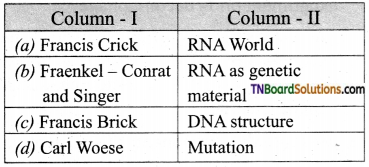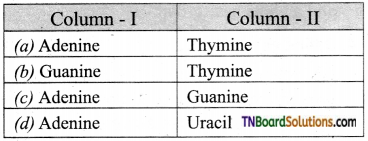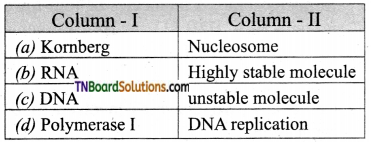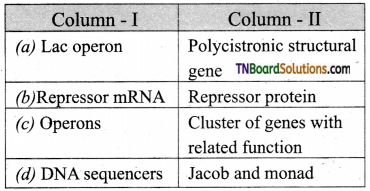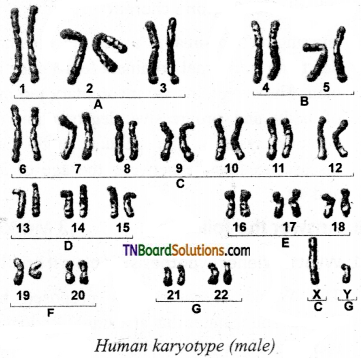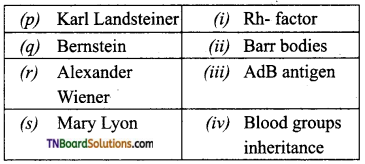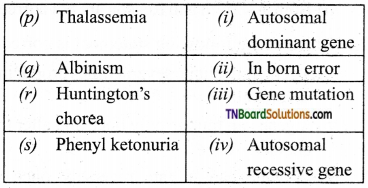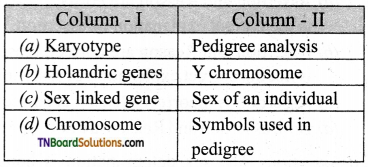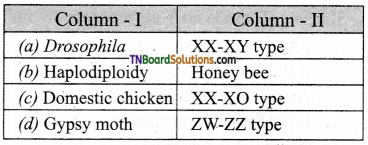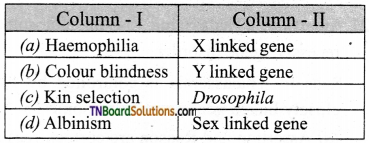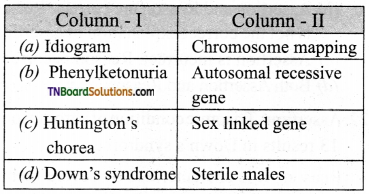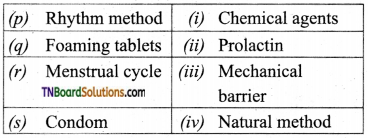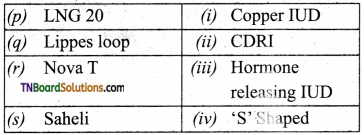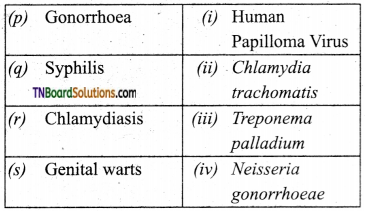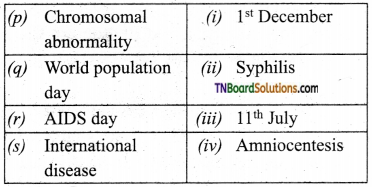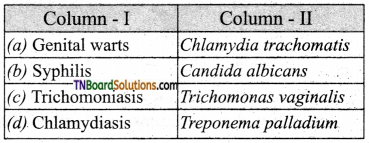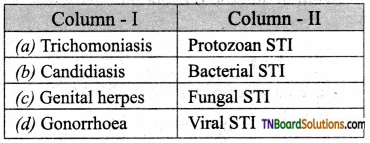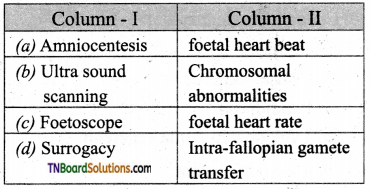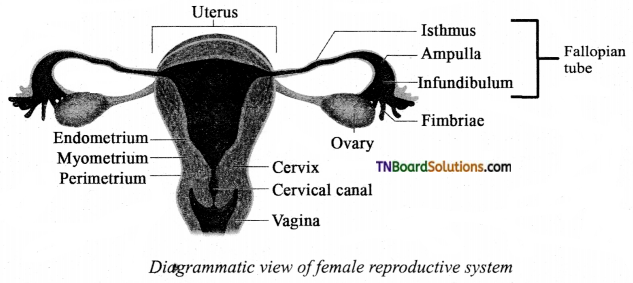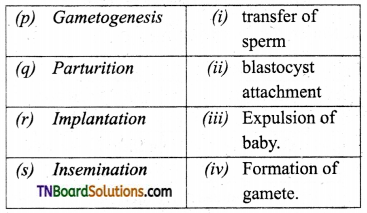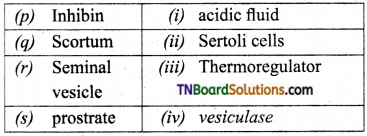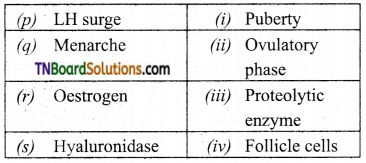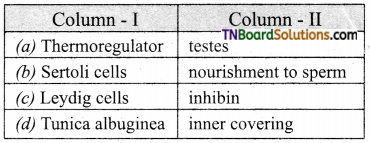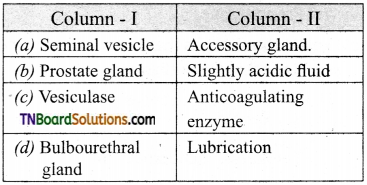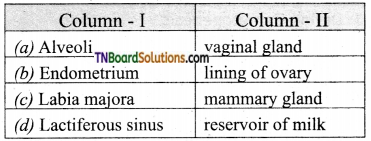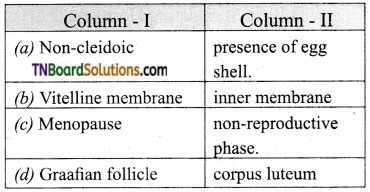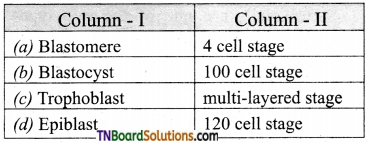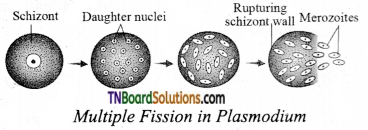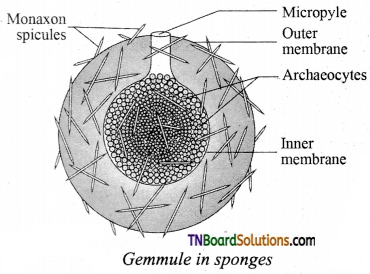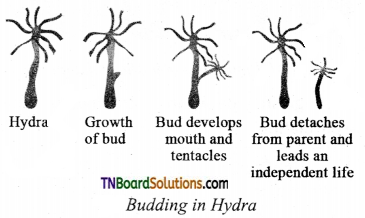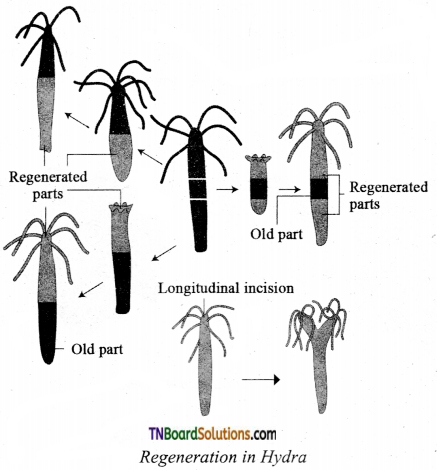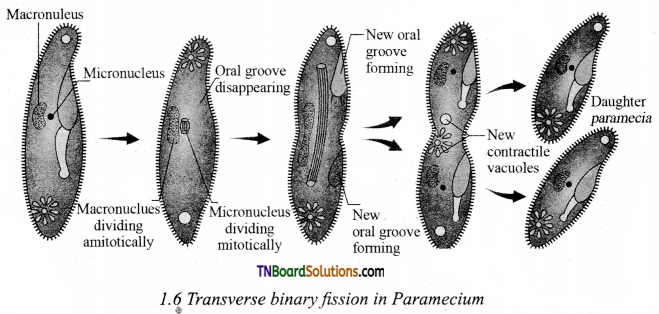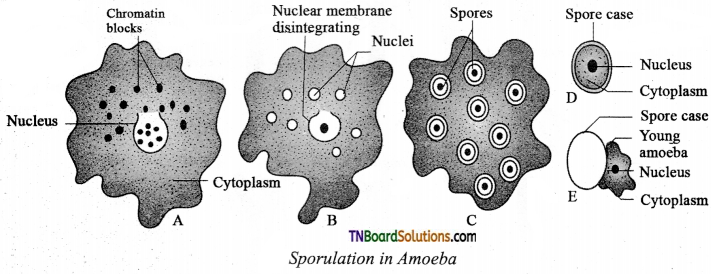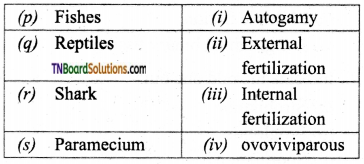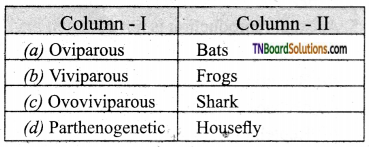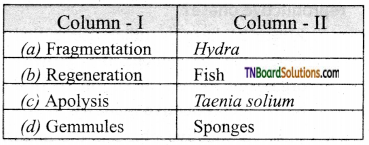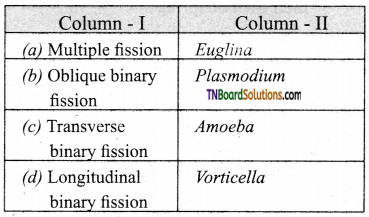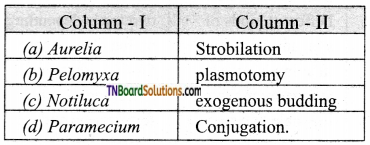Students get through the TN Board 12th Bio Zoology Important Questions Chapter 9 Applications of Biotechnology which is useful for their exam preparation.
TN State Board 12th Bio Zoology Important Questions Chapter 9 Applications of Biotechnology
Very short answer questions
Question 1.
Define Biotechnology.
Answer:
Biotechnology is defined as a branch of Bioscience, through which various techniques of living things are used to make products or provide services for the benefits of human welfare.
Question 2.
Who did produce insulin from dogs? In which year?
Answer:
Best and Banting isolated insulin for the first time from the pancreatic islets of a dog in 1921.
![]()
Question 3.
What is somatic cell nuclear transfer?
Answer:
The somatic cell nuclear transfer is a technique for creating a viable embryo from a body cell and an egg cell.
Question 4.
Where is the gene for the synthesis of Blood-clotting factor VIII located?
Answer:
The genes for the synthesis of blood-clotting factor VIII are located in the X chromosome of a human being.
Question 5.
Distinguish between the traditional vaccine and recombinant vaccine.
Answer:
| Traditional Vaccine | Recombinant Vaccine. |
| These vaccines may produce side effects in some patients. | The recombinant vaccine are of uniform quality and produce less side effects. |
| They are produced comparative less quantity. | They can be produced in large quantities. |
Question 6.
What is meant by an edible vaccine? Explain briefly.
Answer:
Edible Vaccines are produced by introducing selected genes into plants and the transgenic plants are used to manufacture the encoded protein. They cause stimulation of both systemic and mucosal immune responses.
![]()
Question 7.
Explain DNA Vaccine.
Answer:
A DNA Vaccine consists of a gene encoding antigenic proteins, inserted into a plasmid, which is incorporated into the cells of a target animal. This would evoke an antibody response to the free-floating antigen secreted by the cells.
Question 8.
Mention any two trade names of recombinant hepatitis B Vaccine.
Answer:
- Recombivax
- Engerix – B
Question 9.
Expand SCID.
Answer:
SCID means Severe Combined Immune Deficiency.
Question 10.
Define Totypotency.
Answer:
Totypotency is a phenomenon of the ability of a single cell to divide and produces all of the differentiated cells in an organism.
![]()
Question 11.
Expand ELISA.
Answer:
ELISA means “Enzyme-Linked Immunosorbent Assay”
Question 12.
What is the enzyme used in PCR?
Answer:
The enzyme used in the PCR technique for synthesis DNA is Tag – DNA polymerase.
Short answer questions
Question 1.
Distinguish between traditional insulin and recombinant insulin.
Answer:
| Traditional insulin | Recombinant insulin. |
| In evokes same allergic reactions in some diabetic patients due to minor differences in structure of the animal insulin as compared to human insulin. | Recombinant insulin is structurally uniform as that of human insulin and hence there may not be any allergic reaction in diabetic patients. |
| It can be produced comparative lesser quantity. | It can be produced in large quantities. |
Question 2.
Explain how recombinant hGH is produced?
Answer:
A recombinant form of human growth hormone is called somatropin. This can be produced using recombinant DNA technology. The gene for hGH is isolated from the cell of the human pituitary gland and is inserted into a plasmid vector and then transferred to E.coli, which starts producing human growth hormone. The recombinant E.coli are mass cultured for mass production of this hormone using fermentation technology. This hormone is used as a drug to treat growth disorders in children.
![]()
Question 3.
Why did scientists choose yeast instead of E.coli for the production of interferon?
Answer:
Scientists preferred yeast, saccharomyces cerevisiae to E.coli for the production of interferon because E.coli does not possess the machinery for glycosylation of proteins, which is an essential part of recombinant interferon production.
Question 4.
Mention the three types of vaccine.
Answer:
The three types of vaccine are:
- Subunit recombinant vaccine.
- Attenuated recombinant vaccine and
- DNA vaccine.
Question 5.
Write about stem cell banks.
Answer:
A stem cell bank is a place where the storage of stem cells, extracted and processed in laboratories. They may be used for the treatment of disease in the future when needed. Amniotic stem cells are derived from amniotic fluid and stored in an amniotic cell bank for future use. The cord blood stem cells are extracted from the umbilical cord during childbirth and stored in cord blood banks. The umbilical cord and umbilical blood are the main sources of stem cells, whereas, the placenta, amniotic sac, and amniotic fluid are also rich sources of quality stem cells.
![]()
Question 6.
What are natural protein adhesives? Mention their uses.
Answer:
Natural protein adhesives are produced by genetically engineered organisms and are non-toxic, biodegradable, and rarely trigger immune responses.
The uses of these protein adhesives include the reattachment of tendons and tissues, filling cavities in teeth, and broken bone repair.
Question 7.
List any three advantages of animal cloning.
Answer:
- Animal cloning offers benefits for clinical trials and medical research.
- It can help in the production of proteins and drugs in the field of medicine.
- Animal cloning could help to restore endangered species.
Long answer questions
Question 1.
Draw the schematic representation of the production of human growth hormone.
Answer:
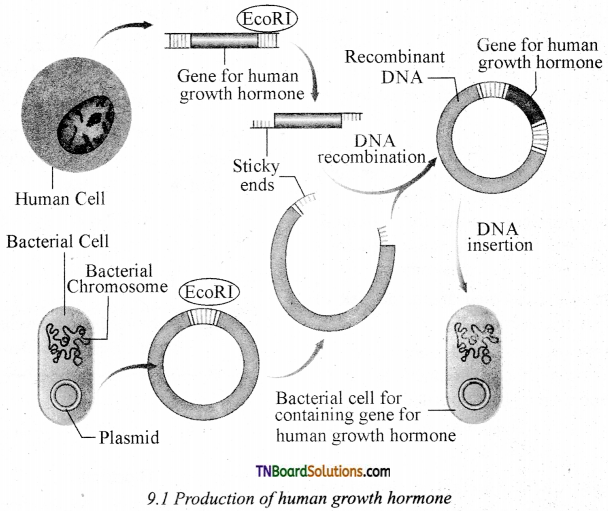
![]()
Question 2.
Draw the schematic diagram of the production of recombinant HB Vaccine.
Answer:
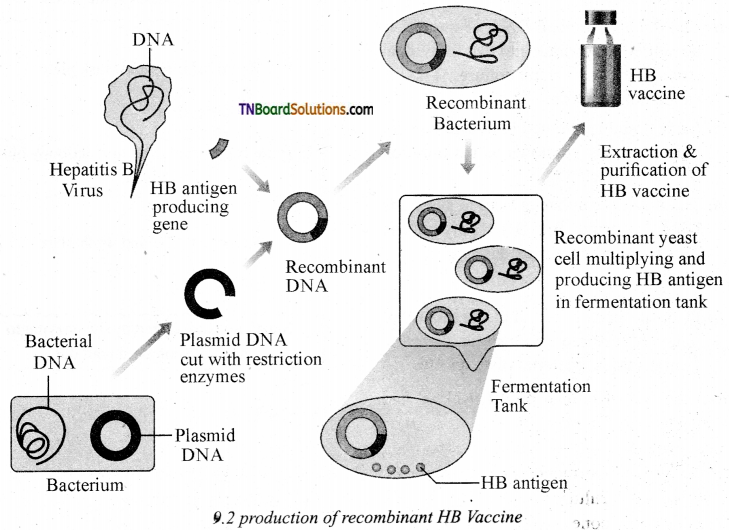
Question 3.
List the ethical issues encountered with the advent of Biotechnology.
Answer:
The following ethical issues encountered
- Modern Biotechnology deals with genetic manipulation, which is against nature.
- This genetic manipulation may lead to unknown consequences.
- The major apprehension of recombinant DNA technology is that this technology may be misused deliberately for producing microorganisms for the purpose of war and this would cause epidemics and environmental catastrophes.
- Many are concerned about the risk of genetic engineering.
- Genetically modified organisms if introduced in the environment, the native organisms may be eliminated.
![]()
Question 4.
What are the steps involved in Polymerase Chain Reaction? Mention its uses.
Answer:
Polymerase Chain Reaction is carried out through denaturation, renaturation, or primer annealing and synthesis or primer extension.
- The double-stranded DNA of interest is denatured to separate into two individual strands by high temperature. This is called denaturation.
- Each strand is allowed to hybridize with a primer. This is known as renaturation or primer annealing.
- The primer template is used to synthesis DNA by using Tag DNA polymerase. This is called primer extension.
Uses of PCR:
- PCR is useful for the diagnosis of an inherited disorder or genetic diseases, viral diseases, bacterial diseases, etc.
- PCR is used to study the differences in the genomes of two different organisms.
- In the field of forensic medicine, PCR can be used.
- Several virally induced cancers like cervical cancer caused by papillomavirus can be detected by PCR.
- PCR is also used in the amplification of specific DNA segments, which is to be used in gene therapy.
Question 5.
Write down the steps involved in ELISA diagnosis.
Answer:
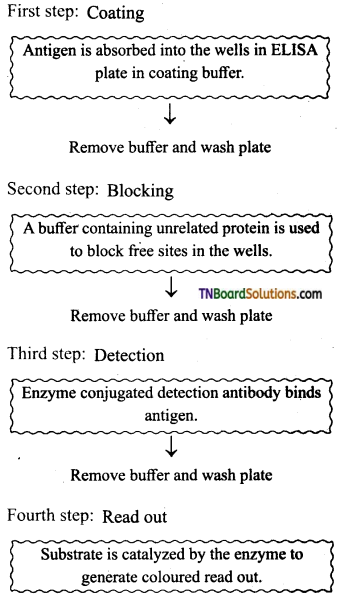
![]()
Choose the correct answers:
1. Match the following.
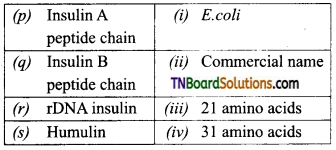
(a) (p)-(iv); (q)-(iii); (r)-(ii); (s)-(i)
(b) (p)-(iii); (q)-(iv); (r)-(i); (s)-(ii)
(c) (p)-(iii); (q)-(iv); (r)-(ii); (s)-(i)
(d) (p)-(ii); (q)-(i); (r)-(iv); (s)-(iii)
Answer:
(b) (p)-(iii); (q)-(iv); (r)-(i); (s)-(ii)
2. Match the following.
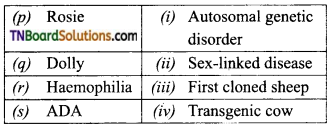
(a) (p)-(iv); (q)-(iii); (r)-(ii); (s)-(i)
(b) (p)-(iv); (q)-(iii); (r)-(i); (s)-(ii)
(c) (p)-(ii); (q)-(i); (r)-(iv); (s)-(iii)
(d) (p)-(iii); (q)-(iv); (r)-(if; (s)-(ii)
Answer:
(a) (p)-(iv); (q)-(iii); (r)-(ii); (s)-(i)
![]()
3. Match the following.

(a) (p)-(iv); (q)-(iii); (r)-(ii); (s)-(i)
(b) (p)-(iii); (q)-(iv); (r)-(ii); (s)-(i)
(c) (p)-(iii); (q)-(iv); (r)-(i); (s)-(ii)
(d) (p)-(ii); (q)-(i); (r)-(iv); (s)-(iii)
Answer:
(c) (p)-(iii); (q)-(iv); (r)-(i); (s)-(ii)
4. Match the following.
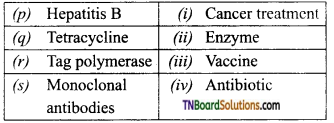
(a) (p)-(iv); (q)-(iii); (r)-(ii); (s)-(i)
(b) (p)-(iv); (q)-(iii); (r)-(i); (s)-(ii)
(c) (p)-(ii); (q)-(i); (r)-(iv); (s)-(iii)
(d) (p)-(iii); (q)-(iv); (r)-(ii); (s)-(i)
Answer:
(d) (p)-(iii); (q)-(iv); (r)-(ii); (s)-(i)
5. Which of the following transgenic animals?
(a) Rosie
(b) Dolly
(c) Wooly
(d) Somatic hybride
Answer:
(a) Rosie
![]()
6. Animal cloning involves
(a) transfer of gene
(b) the phenomenon of totipotency
(c) somatic cells
(d) tumor cells
Answer:
(b) the phenomenon of totipotency
7. In the PCR technique, which acts as the template?
(a) DNA molecule
(b) RNA
(c) mRNA
(d) cDNA
Answer:
(d) cDNA
8. In the ELISA test, the final activity of the enzyme yields a colored product indicating the presence of:
(a) Antibody
(b) Antigen
(c) Pathogen
(d) Infection
Answer:
(b) Antigen
9. Choose the odd man out.
(a) Kary Mullis
(b) Eva Engwell
(c) Darwin
(d) Peter Perlmanin
Answer:
(c) Darwin
![]()
10. Find out the odd one:
(a) ELISA
(b) PCR
(c) ADA
(d) Western plot
Answer:
(c) ADA
11. Chose the odd one:
(a) Denaturation
(b) Fragmentation
(c) Annealing
(d) Extension
Answer:
(b) Fragmentation
12. Identify the odd one:
(a) Human blood-clotting factor III
(b) Sex-linked disease
(c) Y chromosome-linked disease
(d) Haemophilia
Answer:
(c) Y chromosome-linked disease
13. Choose the odd man out:
(a) Best
(b) Peter Flemming
(c) Banting
(d) Rosie
Answer:
(d) Rosie
![]()
14. Which of the following is a correct pair?
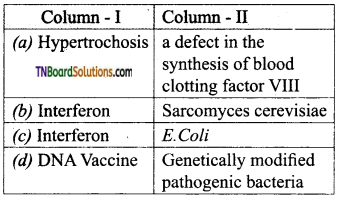
Answer:
(b)
15. Choose the incorrect pair.
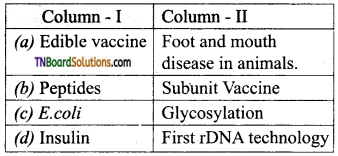
Answer:
(c)
16. Choose the correct pair.
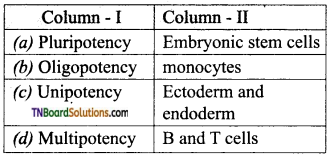
Answer:
(a)
17. Assertion: Stem cells can differentiate into all types of cell that are derived from any of the three germ layers of ectoderm, endoderm and mesoderm.
Reason: Because stem cells are multipotent.
(a) Both Assertion and Reason are correct, Reason is the correct explanation of Assertion.
(b) Both Assertion and Reason are correct, Reason is not the correct explanation of Assertion.
(c) Assertion is not correct, Reason is correct.
(d) Assertion is correct, Reason is not correct.
(e) Both Assertion and Reason are not correct.
Answer:
(a) Both Assertion and Reason are correct, Reason is the correct explanation of Assertion.
![]()
18. Assertion: The differences in the genomes of two organisms can be identified by PCR technique.
Reason: It can detect any quantity of DNA from any source.
(a) Both Assertion and Reason are correct, Reason is the correct explanation of Assertion.
(b) Both Assertion and Reason are correct, Reason is not the correct explanation of Assertion.
(c) Assertion is not correct, Reason is correct.
(d) Assertion is correct, Reason is not correct.
(e) Both Assertion and Reason are not correct.
Answer:
(b) Both Assertion and Reason are correct, Reason is not the correct explanation of Assertion.
19. Assertion: ADA deficiency is an autosomal recessive metabolic disorder.
Reason: In this patient, the T lymphocytes can elicit an immune response against invading pathogens.
(a) Both Assertion and Reason are correct, Reason is the correct explanation of Assertion.
(b) Both Assertion and Reason are correct, Reason is not the correct explanation of Assertion.
(c) Assertion is not correct, Reason is correct.
(d) Assertion is correct, Reason is not correct.
(e) Both Assertion and Reason are not correct.
Answer:
(d) Assertion is correct, Reason is not correct.
20. Assertion: Interferons stimulate the cellular DNA to produce antiviral enzymes.
Reason: They inhibit viral replication and protect the cells.
(a) Both Assertion and Reason are correct, Reason is the correct explanation of Assertion.
(b) Both Assertion and Reason are correct, Reason is not the correct explanation of Assertion.
(c) Assertion is not correct, Reason is correct.
(d) Assertion is correct, Reason is not correct.
(e) Both Assertion and Reason are not correct.
Answer:
(b) Both Assertion and Reason are correct, Reason is not the correct explanation of Assertion.
21. Which of the following statement is correct?
(a) Recombinant hepatitis B vaccine is produced by cloning hepatitis B surface antigen.
(b) Hepatitis B vaccine is produced using E.Coli.
(c) Hepatic B vaccine is not an effective immune inducer.
(d) Nome of the above.
Answer:
(a) Recombinant hepatitis B vaccine is produced by cloning hepatitis B surface antigen.
![]()
22. Choose the incorrect statement.
(a) Stem cells are undifferentiated cells found in most of multicellular animals.
(b) They maintain their undifferentiated state even after undergoing numerous mitotic divisions.
(c) Human embryonic stem cells are unipotent.
(d) Human embryonic stem cells are pluripotent.
Answer:
(c) Human embryonic stem cells are unipotent.
23. Find out the correct statement.
(a) Transgenesis is a tool to study immune response.
(b) Transgenesis helps in the identification of viruses.
(c) Transgenesis is a powerful tool to study gene expression.
(d) None of the above.
Answer:
(c) Transgenesis is a powerful tool to study gene expression.
24. Choose the incorrect statement.
(a) Animal cloning aids stem cell research.
(b) Animal cloning process is tedious and very expensive.
(c) Animal cloning helps to save endangered species.
(d) All the statements are not correct.
Answer:
(d) All the statements are not correct.
